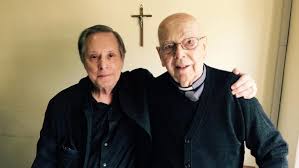Decades after The Exorcist’s release in 1973, its Oscar-winning director William Friedkin returned to the subject matter for a documentary entitled The Devil and Father Amorth, now streaming on Netflix. Set in Georgetown, where The Exorcist was filmed, and Italy, the documentary features a real-life exorcism performed by Vatican-sanctioned Father Amorth.
Raised Roman Catholic, I was generally unnerved after first watching The Exorcist. I was less terrified by Regan’s (Linda Blair) head-spinning and vomiting scenes and more spooked by the idea that some demonic presence would chose to possess an innocent 13-year-old girl for no apparent reason other than it wanted a showdown with a priest, a battle of good versus evil. The film was an adaptation of the novel by William Peter Blatty, who based the novel and screenplay on accounts of a Georgetown boy who was allegedly possessed in 1949. Blatty believed that something supernatural was at work, and Friedkin’s new documentary contains two old interviews with Blatty that restate his belief in the story.
While Friedkin never comes out in the documentary and fully says that he believes in the possibility of demonic possession, he does acknowledge that it’s possible there is another dimension to this world that we can’t comprehend. Yet, Friedkin never fully analyzes or acknowledges the cultural impact of his 1973 film. There are featurette-like scenes where he returns to the location of filming, including the famous staircase that’s such an important part of the film’s iconic ending, but he doesn’t acknowledge that maybe the belief in demonic possession exists because of films like Rosemary’s Baby and The Exorcist, which were released at the height of the “God Is Dead” moment and got people back to church.

(William Friedkin and Father Amorth)
Early in the documentary, Friedkin says that there are over 60 million citizens in Italy and about 500,000 have seen an exorcist. Let that statistic sink in for a moment. Roughly half a million Italians have seen an exorcist.
The exorcism that Friedkin films, his first time ever doing so, was performed on 40-something Cristina. It was her ninth exorcism. As Father Amorth tries to banish the demons, Cristina writhes in her seat, held down by family members and friends. She speaks in a gravelly voice not that much different from Regan’s. When I watched this scene, I had two questions: did Friedkin do something with the audio and was Cristina acting like she thinks a possessed person should behave?
In an interview with NPR, Friedkin said of Cristina:
She was an architect, and a very attractive, intelligent, soft-spoken, wonderful woman. And when she came into the room, I wondered: What is she doing here? What’s this woman doing here? She seems to me to be totally together. And then during the exorcism, she completely unraveled. She spoke in a voice that was completely different from her own. She had what I would say was an unnatural amount of strength for a woman of her size and age. And her entire personality had altered.
I was scared, seriously scared. I was two feet away from them … And it was terrifying. Gradually my fear turned into empathy for her. She was in seemingly unnatural and total pain.
The exorcism runs for about 15 minutes, and at times, it is quite dull. For most of it, Cristina squirms in the chair and growls in a trance-like state, while friends and family around her pray. It would have been more interesting if we actually knew more about Cristina and cared about her fate. Yet, the documentary never dives into her story.

(Cristina and Father Amorth)
The director then shows the footage to neurologists at UCLA and Columbia. They admit that they can’t pinpoint what’s causing her behavior and they don’t debunk the footage. However, one of the specialists at Columbia says that if Cristina and her loved ones generally believe in the supernatural and the possibility of demonic possession, and if that is part of their reality, then an exorcism may be the best medicine for her behavior. I wish that Friedkin asked Cristina if she ever watched The Exorcist because I kept wondering how much popular culture has impacted her belief in the supernatural.
Sadly, Father Amorth, who was in his 90s, passed away not long after Friedkin finished the documentary. He was one of the warmest and funniest aspects of the film. He even had a ritual of literally thumbing his nose at the devil before performing an exorcism. Friedkin tried to reach out to Cristina again but had no luck. Her symptoms, however, did not end after the exorcism. Could there have been other reasons for her distress, financial or personal even? We’ll never know.
Even though The Devil and Father Amorth features footage of a real exorcism, it feels rather hollow. Friedkin is an accomplished filmmaker, and yet his characters in the documentary feel flat. Why didn’t he explore Father Amorth’s theories about evil and exorcisms, for instance? Why no serious interviews with Cristina? The film does raise some thought-provoking questions about belief in the supernatural, but The Exoricist makes a better case for real, raw evil because it contains characters that are fleshed out and well-developed. When a single mother watches her child succumb to the demon, we care what happens to them because we’ve gotten to know them. I can’t stay I know anything about Cristina after watching Friedkin’s documentary. Fans of The Exorcist should still check out the film because it may be the last time that Friedkin returns to the subject matter.